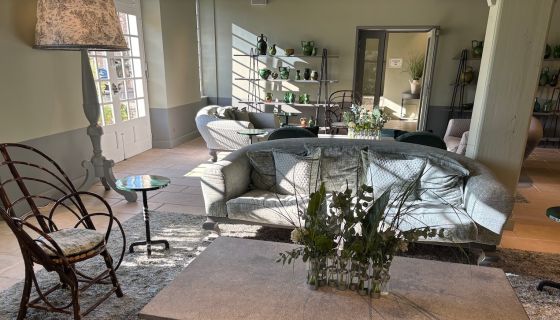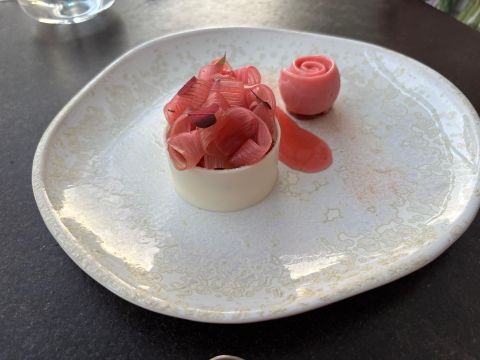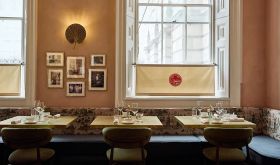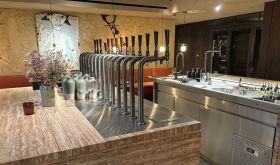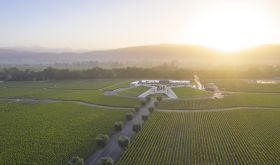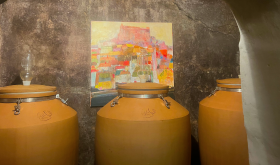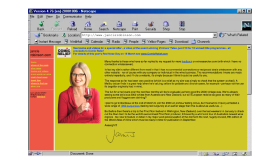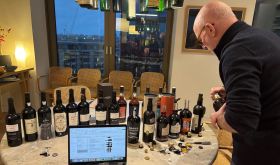Burgundy was looking fabulous.
The weekend before our arrival there had been torrential rain – up to 50 mm (2 in) in certain areas – followed almost immediately by a heatwave. The sunshine seemed to reach every corner of every village and every brilliantly green vine.
The proud stone buildings seemed almost to glisten in the sunshine and roses were everywhere. I had never before seen the succession of evocative village names as we drove cross-country from Pernand-Vergelesses via Savigny-lès-Beaune, Pommard and Meursault to Puligny-Montrachet. It was a magical half-hour.
And then we arrived in tranquil Puligny. The village square was quiet even at 7 pm on a Friday, the only sound being that of its fountain. The whole scene was picture-perfect.
Our destination was the restaurant of the hotel Como Le Montrachet, which occupies one side of the square. Le Montrachet, virtually on the doorstep of the original Domaine Leflaive, will have been well known to many a visitor to Burgundy, but a few years ago was sold to the Como group of international luxury hotels.
My guest was the wife of a well-known British wine merchant who specialises in burgundy while our spouses dined elsewhere. We were unlike many of the other guests who, in a large part from across the Atlantic, looked as though they had booked in for a night or two with perhaps a tour of the local vineyards included.
The receptionist at the hotel, which boasts an extremely elegant facade, was occupied by an American couple when we walked in so we turned to the right and sat ourselves down on the terrace. A massive wine list soon followed, from which I was able to choose a couple of modest, 10-cl, glasses of Puligny-Montrachet, Les Folatières 2023 from their bank of wines available by the glass. As we enjoyed our wine, a number of guests were shown into the restaurant behind us. When eventually we were called through to our table, it was to the last unoccupied table, by the garden but also, unfortunately, right by a speaker of their turgid music.
Our view was delightful and became even more so as the night fell. But we were hungry and quickly devoured the menus put before us which contained both good and less good news. The former was the menu’s layout and emphasis which set out both the chef’s name, Romain Versino, as well as a brief outline of his philosophy of cooking and, most unusually, that of the restaurant’s pastry chef, Adrien Lacombe. (Sadly, we were not to meet either of them.) This only whetted our appetites.
But these were dampened somewhat by the relative lack of choice. There were four starters, including a serving of caviar; two vegetarian main courses, two fish main courses and two meat; plus four desserts and a couple of tasting menus that were compilations of these dishes. Now I know the logistics of running a restaurant in a hotel that is open 24/7 are tricky and they are probably made even more so by French employment laws. The difficulties are doubtless accentuated in a reasonably small, remote wine village where the availability of young men and women is invariably limited, so staffing Le Montrachet must be extremely difficult.
But why not offer a little more choice and close one day a week, perhaps in conjunction with a local restaurant that stays open that day? Or offer a less complicated menu one day a week? The amount of culinary preparation involved in these nine savoury dishes is obviously labour-intensive so why not try to minimise this? There are plenty of excellent alternative options available, particularly in this region so well endowed with food and wine suppliers.
But this brings me on to a bigger criticism of this restaurant, which opened in the difficult year of 2023 (remember that just-post-COVID era?). What both my guest and I found most disquieting about our visit was the lack of warmth at the reception; the offhand, almost cold, approach of the waiting staff; and the absence of any word of thanks – or even a bon voyage – from any member of staff at the end of a meal for which I had paid €313. This was even though, since our table was the furthest from the exit, we had to walk the whole length of the restaurant past several members of staff to get to our car.
There are two explanations for this, and only one solution. The first is that the restaurant is in a reasonably conservative area of France in a business where change happens only at a snail’s pace. The second is that presumably it was a management decision to have the waiting staff so formally dressed in white shirts (I inadvertently typed shorts!), black trousers and black jackets with several proudly wearing sommeliers’ badges in their lapels. I assume the staff are dressed like this, even in a quiet village in the country, in an effort to reinforce the notion that the cooking is of a serious nature.
But, as I wrote back in 2022, staff uniforms are changing. In fact, spurred on by COVID, many restaurateurs have been relaxing their dress codes in an attempt to lure staff back to the industry. I am not saying that here every member of staff should be allowed a freedom of choice, but that formal black look seemed off-puttingly inappropriate in such a rural setting. With the numerous connections the Ong family, owners of the Como group, have to the fashion industry, they ought to be leading this change. I ended my 2022 article by quoting a veteran of British hospitality who said, ‘the world is moving away from uniforms to one that is dominated by “style guides”’. I think the restaurant would feel much more welcoming, and the staff might even relax more, if they were less formally dressed.
That said, the food we ate was very good, and very intricately presented; from the bread to the amuse-bouches to our first courses, of which an elegant trio of green asparagus came grilled and served alongside a hefty garlic pesto.
There was only one problem with my dish, a bowl of what was described as a parsley emulsion, more precisely a soup, in which lay a dozen extremely burgundian snails. The problem was the absence of a spoon to eat this with, which was soon resolved but the spoon was delivered without a smile.
Our main courses were very different. The fillet of Arctic char came wrapped in a thin coating of artichokes with summery morels to one side.
My sweetbreads came topped with a thin slice of Colonnata pig fat and a tartelette of peas. The size of the serving was superbly judged, the meat proving extremely rich but delicious and well seasoned.
Desserts were impressive, too, especially a cleverly intricate rendition of a favourite of mine – the rhubarb with rice pudding shown below – which I left to my guest as she is gluten-intolerant. My chocolate dessert was competently done. With this we enjoyed a half-bottle of Puligny-Montrachet 2023 from Sylvain Bzikot for €57 that worked well with each of our very different main courses.
What was surprising about this dinner was the absence of any participation from the chefs. There are several dishes from this small menu that were served to the customers from serving dishes and via small tables which could, and perhaps should, have been ‘finished’ by somebody from the kitchen. This would surely have added interest and might even have brought a smile to the faces of the waiting staff.
Como Le Montrachet 10 place du Pasquier de la Fontaine, 21190 Puligny-Montrachet, France; tel: +33 (0)3 80 21 30 06
Read 158 reviews of wines from Le Montrachet grand cru vineyard after which this hotel-restaurant was named.

